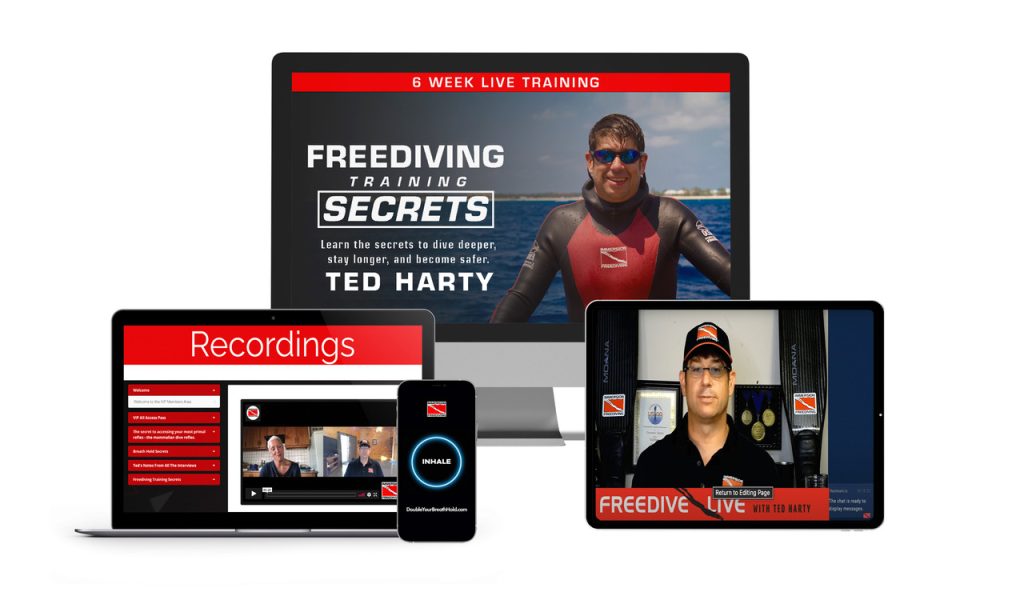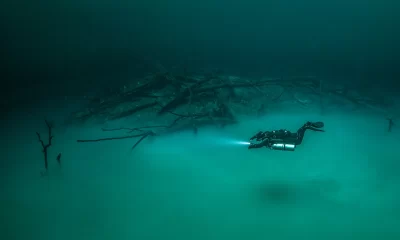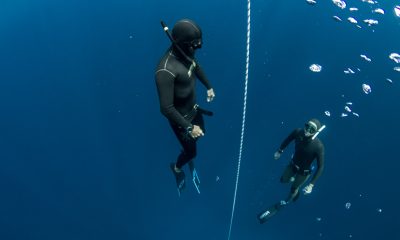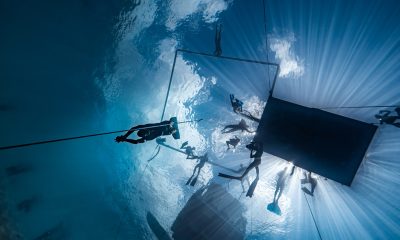Community
Is Freediving Safe?
According to DAN, breath-hold diving fatalities accounted for nearly a third, or 52 of the 162 recreational scuba deaths in 2017, and four times the number of tech diving fatalities that year. Is freediving actually more dangerous than tech diving? Former USA Freediving Team captain, record holder, and PFI instructor-trainer Ted Harty explains what’s happening and what’s required to improve freediving safety. Take a deep breath.
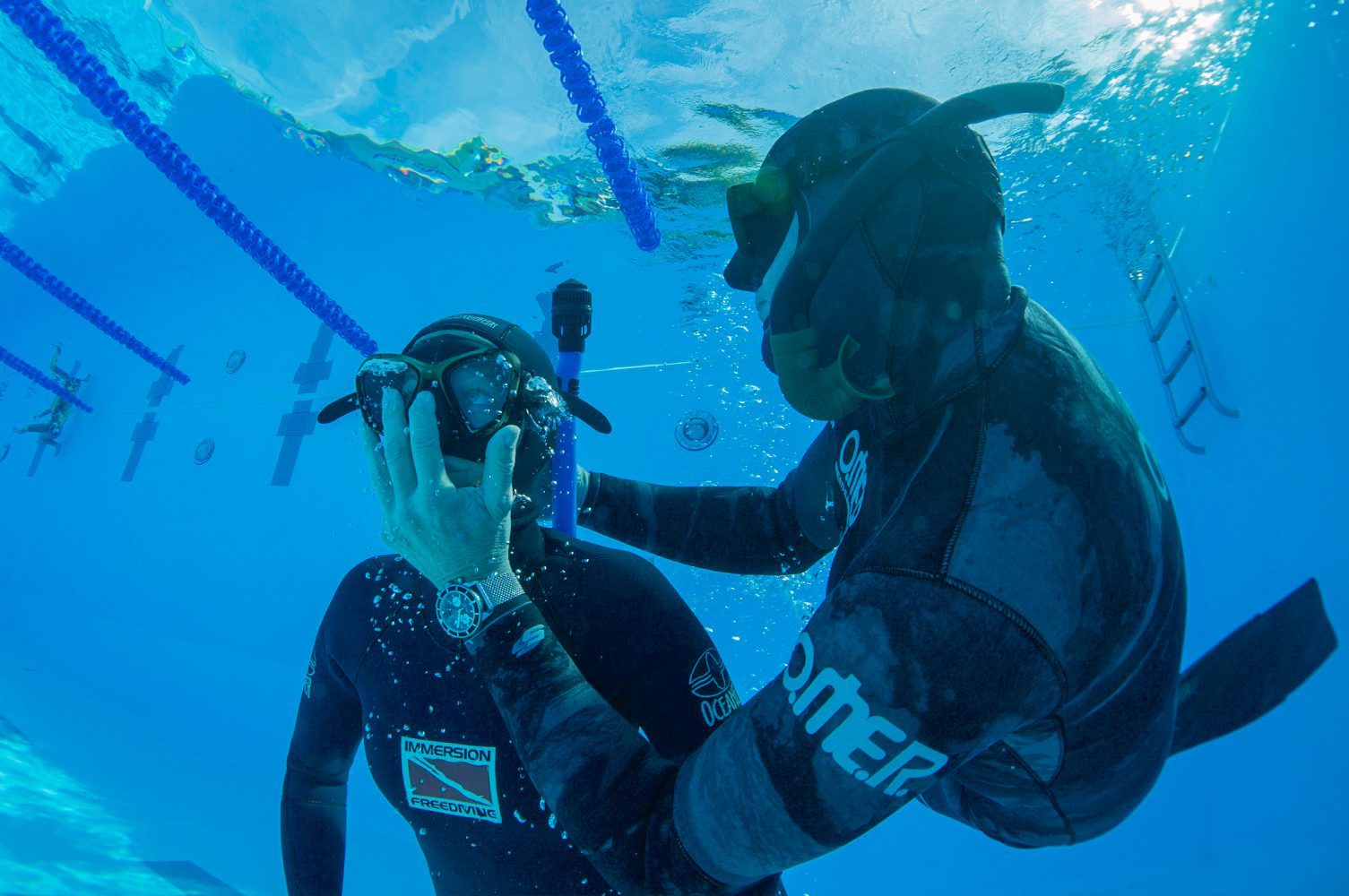
by Ted Harty
All photos courtesy of Ted Harty unless specified.
Background: Similar to the early days of tech diving, freediving suffers from an alarming number of fatalities. According to the 2019 DAN Annual Diving Report, there were at least 955 breath-hold diving incidents between 2004-2017, with 73% fatal outcomes—or an average of at least 51 fatalities per year. DAN rigorously collects data from public media, breath-hold diving associations, DAN’s Diving Incident Reporting System (DIRS), and individuals.
However, the editors point out that it is highly likely that the data they captured underreports the actual number of breath-hold fatalities. Note also, that freediving competitions, which have a strong safety record, are not the culprit; there have only been two fatalities during competitions in the last 30 years.
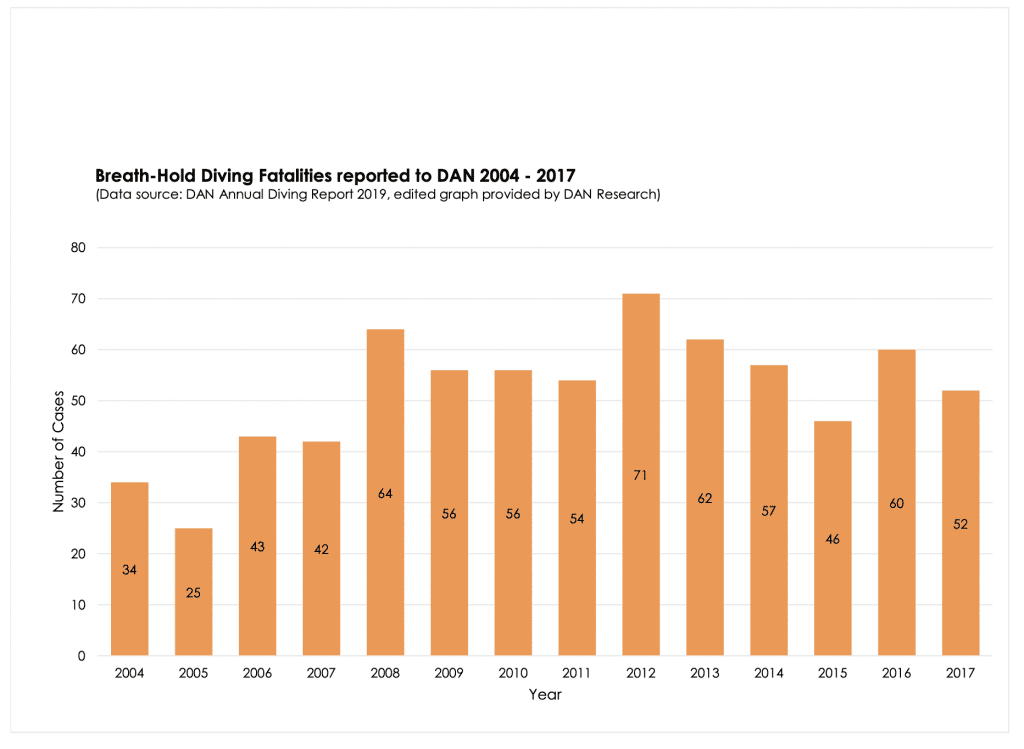
In 2017, (the last year reflected in the DAN report) there were at least 52 freediving fatalities worldwide. By contrast, technical divers accounted for 13 fatalities in 2017, and have ranged between 15-25 a year worldwide—the majority involve rebreather diving—while annual scuba diving fatalities total roughly five times more. In 2017, there were 162 deaths involving recreational scuba diving, 70 in North America. Freediving fatalities, though likely underreported, still accounted for nearly a third of overall recreational diving fatalities.
Which begs the question: Is freediving safe?
The answer is yes. And no. But truthfully, that depends on you. Is scuba diving safe? The best answer to that question is, it depends on how closely you follow safe diving practices. People ask me all the time, isn’t freediving dangerous? My standard response is, “The way most people do it, yes it can be dangerous.” Don’t worry, I teach people how to freedive safely, and you are about to get some insight into the process. If you want to find out if you or your buddy is actually freediving safely, keep reading.
My name is Ted Harty. I’m the founder of Immersion Freediving, and my pride and joy is www.FreedivingSafety.com, a free, online course that teaches all of the safety information that I teach in my in-person classes.
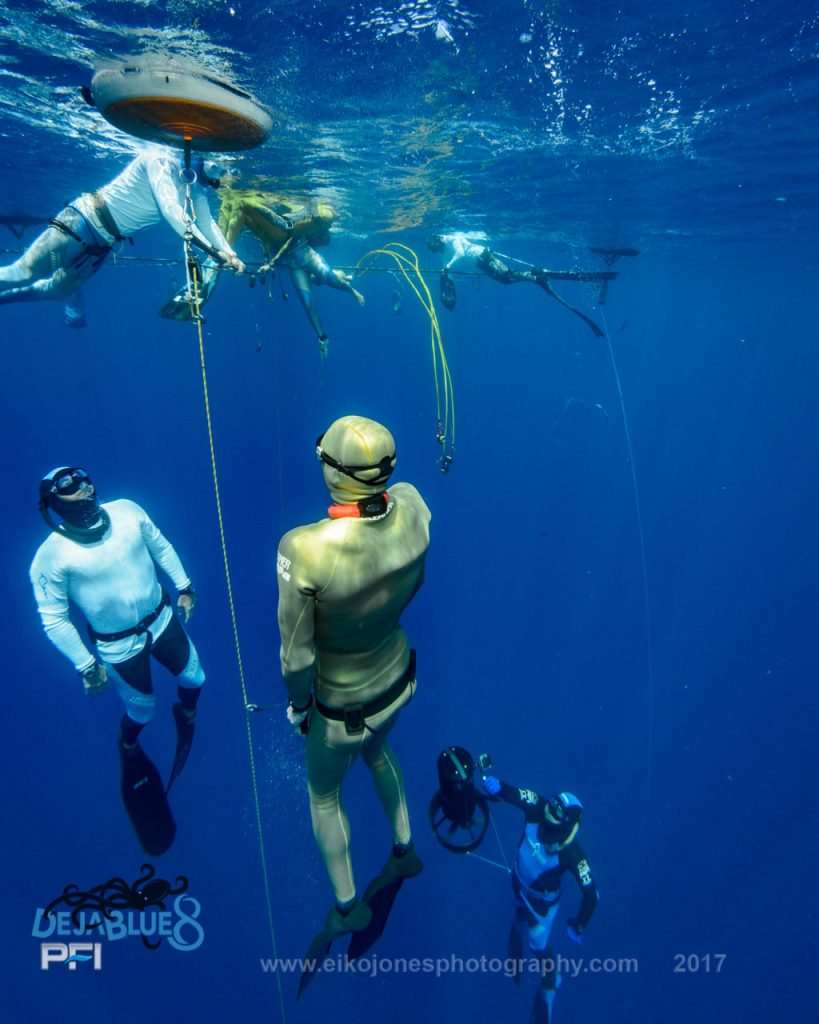
I became a scuba instructor in 2005, and later became an instructor for Performance Freediving International (PFI), eventually achieving the rank of Freediving Instructor Trainer. I am a past USA Freediving record holder, and was the captain of the USA Freediving Team during world championships in France. My deepest freedive is 85 m/279 ft, and my longest breath-hold is seven minutes. I’ve trained a Basic Underwater Demolition/SEAL (BUD/S) instructor, and fitness guru Ben Greenfield. I have also worked with the CEO of Twitter, and I appeared on the Discovery channel with Tim Kennedy.
To most readers of InDepth, my freediving performance likely seems unreal, but when my freediving performances are compared to the world’s best freedivers, my performances are average at best, which I’m fine with. My main focus is on education, specifically safety education for freedivers.
Comparing Freediving To Scuba
To answer the question regarding freediving safety, let’s compare it to something that the majority of you are familiar with: scuba diving.
What does every single scuba diver on the planet have in common? They took a scuba class from a certified instructor. I would argue more than half of a scuba class is what to do when something goes wrong, and how to avoid those situations in the first place. What to do if your mask comes off, or your regulator comes out, or you run out of air, or you run out of air and there is no one nearby, or your regulator is free flowing, etc.
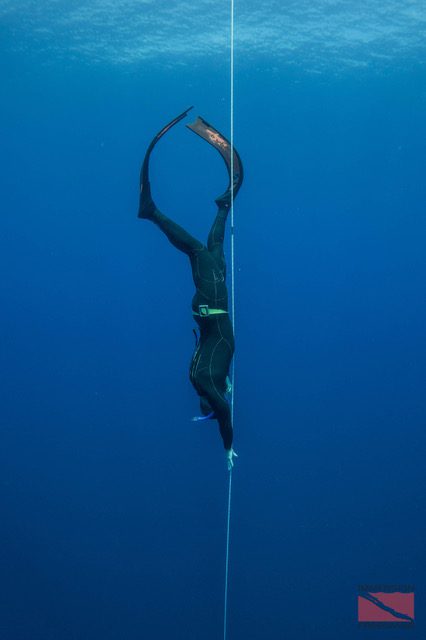
In fact, to become a scuba diver, an instructor will demand that the student jump into the water and convince the instructor that they could easily handle all of these emergency situations. Only when the instructor is convinced the student could handle these emergencies are the students allowed to go scuba diving.
Let’s compare that to freediving.
You walk into a dive shop, and say,“Yeah, gimme those fins—no the long ones. And that wetsuit. No, no, the camo one. And I want that teeny, tiny mask, that camo snorkel, oh yeah and that gun. No, the big one with three bands.” You swipe your credit card, and out the door you go. It’s now up to you to figure out how not to kill yourself.
See the difference?
There is no gatekeeper in freediving. In scuba, you have to have a card to get your tank filled or get on a dive boat. There’s nothing like that in freediving, really. With that being said, most people who freedive have never taken a class. This means they don’t know the rules—the dos, the don’ts, the safety procedures, or even how to rescue their buddy in the event of a problem.
The biggest danger in freediving is a blackout; you may have heard it called shallow water blackout. If the oxygen level in your blood drops below a certain level, the brain can no longer maintain consciousness, and a blackout is the result. Blackouts are not common, just like running out of gas is not common. By the way, I bet you have a solid plan for if you run out of gas, don’t you?
Blackouts can easily be fixed with proper safety protocols and just result in ceasing diving for the rest of the day. If proper safety is not in place, that same blackout can result in the diver sinking to the bottom of the ocean and dying, resulting in yet another Facebook post about someone dying while freediving.
Let’s go over some things most people don’t understand about freediving blackouts.
Where Do Blackouts Happen?
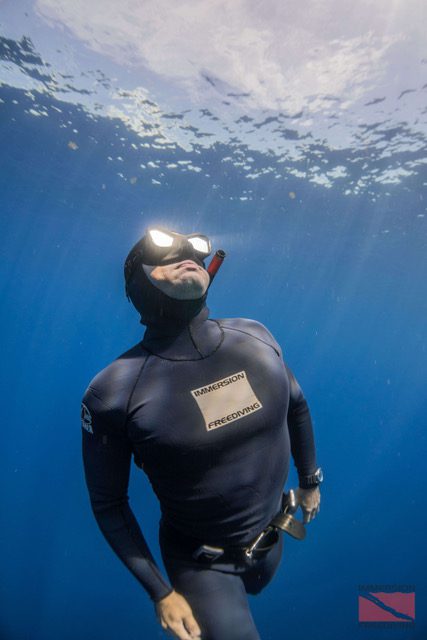
Ninety percent of blackouts happen at the surface after the diver surfaces and takes two to three breaths. Many times, the diver will look fine at the surface. I’ve seen freedivers hit the surface look fine, take a few breaths, give a strong OK sign and then blackout at the surface. Most freedivers don’t know blackouts can happen like this, because most learned from their buddy, not an instructor.
Nine percent of blackouts happen between 4.6 m/15 ft and the surface. So, 99% of blackouts are in the top 4.6 m/15 ft of the water column—what I call swimming pool depths—and can be easily handled, assuming divers are following safe freediving practices and are trained in freediving rescue techniques. Unfortunately, many freedivers do not follow such procedures. More on this later.
What Would You Feel Prior To A Blackout?
Here is the part that most people not only don’t understand, but don’t believe me when I tell them. On a dive that results in a diver having a blackout, they would likely feel fine. I’ve said this for over ten years, and often I’m not believed.
When I was sitting in my PFI Freediving class with Kirk Krack as an instructor in 2008, he told me the same thing, and I didn’t believe him either. I thought, come on, on a dive where I lose consciousness, you are telling me I’d feel fine? No way! You’re just saying that to try to scare us into being more concerned about all this safety stuff you keep talking about.
When asked why this happens and why you wouldn’t feel it coming, I typically say something like this: The reasoning behind that is rather complicated and beyond the scope of this discussion. If I’m teaching an intermediate class, I spend 20 minutes discussing the partial pressure of oxygen and hemoglobin dissociation curves.
But, in this case, because you are tech divers, you are already aware that the partial pressure of oxygen drops extremely rapidly the last 10m/33 ft to the surface. In fact, the partial pressure of oxygen drops by half as you go from 10m/33 ft to the surface.
It takes a freediver roughly 10 seconds to get from 10m/33 ft to the surface. This is why freedivers can blackout so suddenly, as the partial pressure drops very rapidly near the surface.
There is nothing like seeing it first hand for yourself.
Watch the video below to see two separated blackouts while freediving spearfishing.
This first video shows a spear fisherman with 25 years of experience. He has never had a blackout before. This happened on a 15 m/50 ft dive, which is a totally normal depth for him; in fact, he did seven dives on this same spot before the blackout happened.
As you can see, he clearly had no idea anything was wrong, and the person who rescued him was freediving instructor Ren Chapman, from Evolve Freediving, who will tell you that the diver told him on the boat that he felt fine on the dive.
This spear fisherman has 25 years’ experience spearfishing, so let’s say that’s a total of 50,000 individual freedives, which I think is a completely reasonable assumption. I do 60 dives during an ocean session when I’m teaching. That means on 49,999 of his individual freedives, he was fine, but on 1 out of 50,000 freedives he had a blackout.
This diver typically dives by himself or with people who are not watching him properly. So if this blackout had happened during any of his 49,999 other freedives he would have died. On this dive, he was being watched by Ren Chapman of Evolve Freediving, so he was fine.
I have a question for you: Did you catch the moment the spear fisherman asked Ren for help? Of course you didn’t, because he didn’t ask for help, because he didn’t know anything was wrong.
The second video shows one of my students rescuing his buddy after a blackout. In the second video, they were diving in a two-person team. My student went back to the boat and told his buddy, “Hey I gotta head back to the boat. I will be back in just a second, don’t dive till I get back.” His buddy got tired of waiting and thought, I don’t need a babysitter, and did the dive.
As you can see from the video, the only reason he’s alive is because the boat was tied up to the rig, so while he was on the boat, he was extremely close to the diver. Once his buddy surfaced and my student saw what was happening, he jumped off the boat and performed the rescue he learned in my class, and the diver was fine. You can learn how to rescue someone from a blackout in my free online safety course.
The most common thing that people say after being rescued from a blackout is that they didn’t black out. They often don’t believe anything happened. In the second video, the guy that had the blackout refused to believe he had a blackout, and continued to dive. My student was forced to follow him around to make sure it didn’t happen again.
You are much more prone to have a worse blackout that day if you continue diving after a hypoxic issue like a blackout or a loss of motor control.
If you talk to people that have had a blackout, they will more often than not say they felt fine on the dive and didn’t feel that anything was wrong. So here is what we have: With most blackouts, you wouldn’t feel anything was wrong. Why? Because the partial pressure drops extremely rapidly on the ascent. You also saw proof of this with your own eyes in the first blackout.
Now here is where it gets interesting.
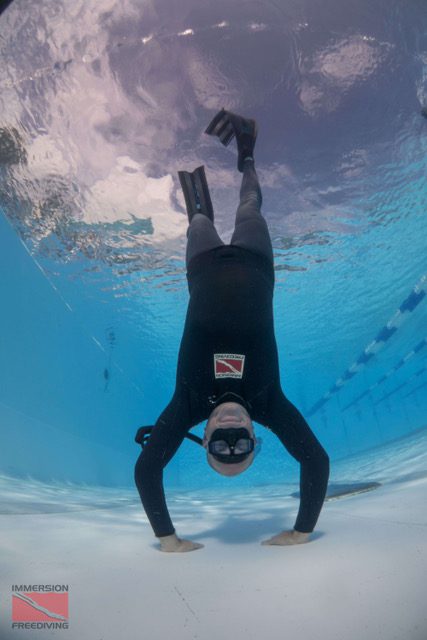
If you ask the average freediver or spearo if they are worried about freediving safety or worried about blacking out, 90% will say something like this: “I don’t push myself. I dive shallow. I know my limits. I’m in tune with my body, it’s those people that push themselves and dive deep that need to worry; not me.”
One week ago in Florida, there was a freediving fatality in shallow water while lobstering. Shallow water doesn’t make you immune. When you dive shallow, you stay longer.
Many freedivers are not worried about having a blackout because they are in tune with their body; yet on a dive that results in a blackout, you would likely feel fine. See the issue here? Let’s say you were, in fact, genetically superior to us mere mortals, and you had some sort of internal blackout sensing device: Let’s put it to use.
You are coming up from a 15 m/50 ft freedive, and your blackout sensing device goes off, and you know you’re going to black out when you hit the surface. How will that information help you in any way? The only thing that will save you at this point is having a buddy who is waiting for you when you surface.
So Now The Question Is Where Is Your Buddy?
First, let’s look at where the buddy needs to be. We teach that divers never freedive alone, but it’s more than that. We teach that when they surface from a freedive, a buddy needs to be what I call, “close enough to grab.” If you have 15 m/50 ft long go-go gadget arms, you can be 15 m/50 ft away from your buddy. If you have normal-sized human arms, you need to be 1 m/3 ft away so you can grab them and immediately stop their airway (mouth and nose) from going into the water if they blackout.
It’s not the blackout that causes the problem, it is the water in the lungs that kills them. You need to be close enough to grab someone to rescue them effectively. This is what we mean when we say “One Up-One Down.” One diver makes a dive, and the second diver stays on the surface and commits to being close enough to grab the diver when they surface. This is the core principle of safe freediving, which is called “direct supervision.”
In my opinion, failure to follow this very simple rule is what leads to most freediving fatalities. If you surface from a dive and have a blackout, and your buddy is 15 m/50 ft away, not paying any attention to you because they just saw a fish and are chasing after it to harvest it or take a photo of it, you’ve got a significant problem, right? How can your buddy save you from a blackout unless they are right next to you when it happens?
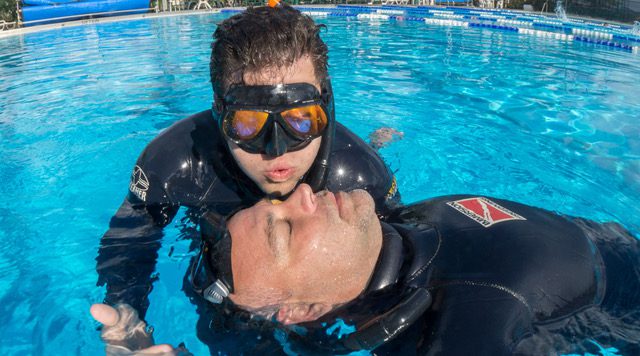
Just having a buddy “in the area” is essentially useless, unless they are committed to direct supervision. When you blackout, you are not going to be hollering for help, you are going to hit the surface, and then, if you are overweighted, slowly sink to the bottom. I’ll talk about weighting a bit later.
We also teach that when your buddy surfaces, you need to watch them for 30 seconds. After 30 seconds of breathing and looking normal, you can be assured they are oxygenated and will not blackout.
Bullet Proof Buddy System—For Scuba Or Freediving
I first started teaching this system when I would divemaster trips in the Florida Keys. I remember a couple who was doing lots of fighting on the boat. They made several trips with us. They would always come up arguing about getting lost and losing each other. The husband came up to me and said they need to take a navigation class because they always lose each other.
I told them I was happy to teach them a navigation class, but I could stop them from losing each other in just 60 seconds. They asked, “How is that possible?” I then asked them, “When you go into the water, who is the designated leader, and who is the designated follower?” They both looked at each other with a dumbfounded look, and I said, “Exactly. You’re both leaders.”
So back to freediving. You jump in the water with your buddy. One of you is the designated follower; the other is the leader. Now the leader gets to go wherever they want. As the follower, you have one goal—stick your face in the water and follow their fin tips. No arguing about why I want to go this way, no discussion; just follow. When the leader makes a dive, your job is to keep an eye on the diver, and when they surface, be close enough to grab and watch for no less than 30 seconds. Then you are the leader. Now you get to go wherever you want, and the other diver has to follow you.
What’s great about this system is it requires no discussion. You don’t have to say, “Hey, I’m about to make a drop. Make sure you’re watching me.”
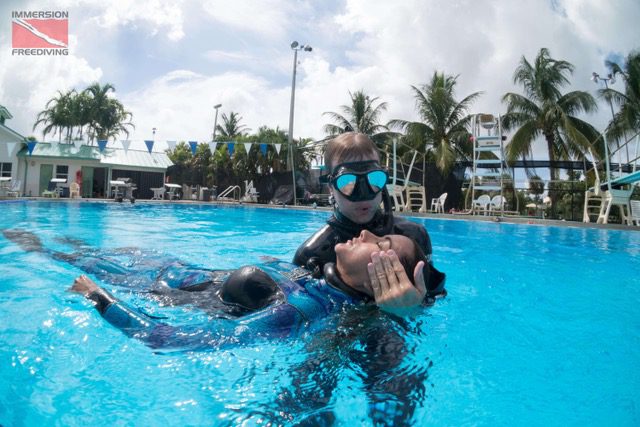
My spearfishing students love this system because it’s very easy to implement. It works great for scuba as well. Switch leader and follower roles between dives one and two, and this way, both divers learn leadership and navigating skills instead of one diver always being reliant on following someone.
Blackouts Vs Running Out Of Gas
Blackouts are not common, just like running out of gas is not common. In scuba, you have a set of procedures set in place so that if you run out of gas it’s easily fixable. If you don’t have a plan to deal with that, and you run out of gas..…oops.
It’s the same with freediving. We have a set of procedures, diving in a team, One Up-One Down, be close enough to grab, and be trained in blackout rescue. This way, if a blackout happens, it’s easily fixable. The problem is many, if not most, people do not follow these procedures. When a blackout happens, it unfortunately often leads to a fatality.
Divers Alert network (DAN) started tracking freediving breath hold fatalities in 2005, but I assure you they are incredibly underreported. In my estimation, there are 50-75 fatalities from breath-holding in the USA alone per year. I’ve heard of four in the past couple of weeks.
Blackout fatality numbers are hard to track. They are not reported nearly as rigorously as scuba fatalities. Divers Alert network (DAN) started tracking freediving breath hold fatalities in 2005, but I assure you they are incredibly underreported. In my estimation, there are 50-75 fatalities from breath-holding in the USA alone per year. I’ve heard of four in the past couple of weeks.
Proper Weighting For Freediving
This is such an important concept, and I find that almost every untrained freediver—and even some that have taken a freediving course—doesn’t fully understand and properly implement safe weighting.
As I said earlier, it’s not the blackout that causes the problem, it’s the water in the lungs that does. When there is a freediving fatality, where is the body found? Typically on the bottom. Why? Because they were wearing too much weight. If you were to blackout, instead of the bottom of the ocean, where would be a better place to end up? On the surface!
I’ve seen countless Youtube videos of spear fisherman blacking out at the surface and then rapidly sinking to the bottom as a result of wearing too much weight.
When you blackout, you let out a very specific amount of air, but it’s not all the air in your lungs. To find out exactly how much air you would let out, follow along with me here.
Take a big breath, then do a relaxed passive exhale like a sigh. That’s exactly how much air you would let out if you blacked out. So you let out some of the air, but not all of the air. Sure, if you forcefully exhaled, you could force more air out, but is a blacked-out freediver going to do anything forcefully? Nope.
When you blackout, you will either float on the surface or sink to the bottom, and that outcome will be determined by the amount of lead you are wearing.
In the below video I simulated a blackout while intentionally wearing too much weight and you can see how fast I was sinking.
Surface Safety Test
Get in the water wearing whatever gear and weight you usually wear. Take a big breath, do a relaxed exhalation like a sigh, don’t kick your feet, don’t move your hands. If you sink, now you know that if you were to blackout, you would end up on the bottom of the ocean. Does this seem like a good setup? Nope!
Take a pound off and repeat the test. Continue taking weight off until you can do the exhalation and not sink. This is what I call passing the surface safety test.
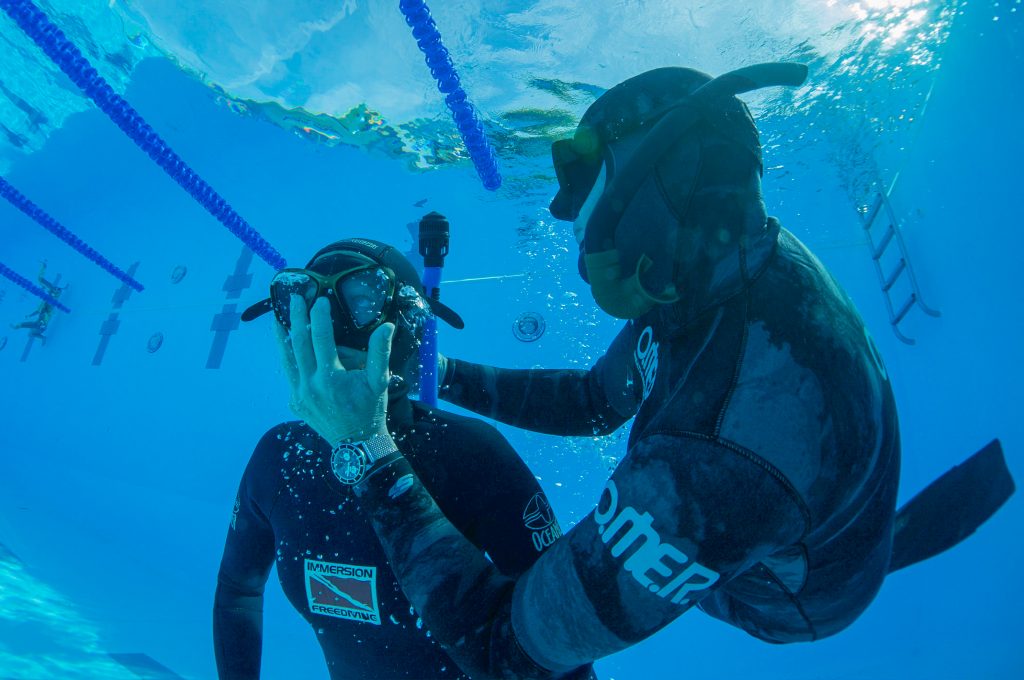
I tell my students that by doing this test, they will make sure they are not overweighted when they’re wearing the exact same gear that they did the test in. If you change your wetsuit, gain or lose weight, switch from fresh to salt, or decide to ditch your wetsuit bottoms, you will have to redo the test and change your weighting.
I tell my students that they should do this test every single time they jump off the boat. If your weight is correct, it will take all of 10 seconds. By being correctly weighted, you will end up floating on the surface if you blackout.
Imagine rescuing someone who had a blackout, which is easier to rescue?
Your buddy who is floating on the surface, or your buddy who is sitting on the bottom at 18m/60ft.
I think the answer is obvious.
Wetsuits Are Not Just For Warmth But For Safety
Here is something most people never consider. Yes, a wetsuit is designed for warmth, but in freediving, it’s also designed for safety. This is a conversation I have all the time with my students.
In this example, let’s say I have a very fit student with muscles and little body fat. I ask them how much weight they wear when they go freediving, and they say, “Oh Ted don’t worry. I don’t wear any weight, I’m super safe.”
I then ask, “What type of wetsuit do you wear?” and they say, “None, I don’t need one.” Then I tell them, “Well that’s a problem because you’re overweighted,” and they always respond, “How can I be overweighted if I’m not wearing any weight?”
If you are a person I would call a sinker—with muscles and low body fat—it’s possible that if you jump in the water with no wetsuit and no weights, and do a relaxed exhalation, you will sink. This means you are overweighted, and you would end up on bottom if you had a blackout out, so you need a wetsuit not just for warmth but for buoyancy.
If I jump in the water with no wetsuit and do a relaxed exhalation, I float, because I have a body built with beer, bourbon, and BBQ. This is not a problem I have.
Should your snorkel be in your mouth while underwater?
Students always have a hard time breaking this snorkel habit, and most untrained freedivers have their snorkels in their mouths when they are underwater. So they are typically a bit surprised by how adamant I am that they remove their snorkels from their mouths when they dive.
I teach my students to take a breath at the surface using their snorkels and then remove the snorkels from their mouths as soon as they take their breath. Like any good instructor, if I’m going to tell students to alter something they have done for a long time, I better have a good reason for why I’m asking them to change, and I’ve got a good one.
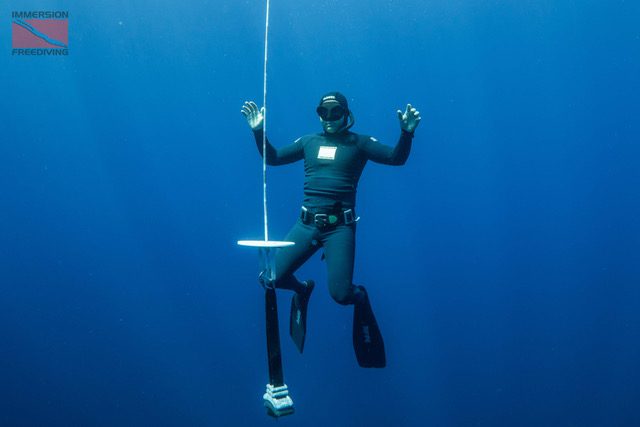
Freediving with your snorkel in your mouth is a drowning hazard!
If you are like most people, you retain the snorkel in your mouth when you are freediving underwater. So I have a question for you. What is stopping the water from rushing into your lungs?
The most common answer I get is my throat is shut. That is not what’s stopping it, because if it was your throat, that would mean when diving underwater with the snorkel, your entire mouth is full of water up to the back of your throat. I doubt you are diving like that.
The actual reason the water isn’t going into your throat is your tongue. Your tongue is actively plugging the hole of the snorkel, and that’s what stops the water from going into your lungs. The tongue stops the water from even getting your mouth. Okay, now you’re thinking, why are we talking about my tongue?
Next question: If you were to blackout underwater with the snorkel in your mouth, will your tongue continue to actively block that hole? Nope! Why? Because you are unconscious, your tongue is going to go limp like everything else. You can’t count on it continuing to block that hole.
So if you blackout with the snorkel in your mouth, the snorkel will turn into a funnel that channels the entire Atlantic ocean directly into your lungs.
Does this sound like a good idea? Not to me!
That is why having the snorkel in your mouth while underwater is a drowning hazard. It’s why most freediving courses will teach you to remove your snorkel upon descent. Even if your attentive buddy rescues you quickly if you blackout, if you had a snorkel in your mouth, you could still end up in the hospital for a week or more, because water got into your lungs.
When you don’t have the snorkel in your mouth, and you blackout, your mouth is going to stay closed. Why? Because it was likely closed to begin with, and the water pressure will help keep it closed. When you blackout, you are not going to open your mouth because that is an active process and when you are unconscious, you are not going to be doing anything active.
One of the main rules in freediving is to protect the airway. As long as we keep water from going in the mouth or nose, we protect the lungs. As long as no water gets in the lungs, the diver will be fine. As I said before, it’s not the blackout that causes us the problem; it’s the water in the lungs.
My Prescription For Safe Freediving Is Simple
It’s simple: Dive in a team, One Up-One Down, be close enough to grab when your buddy surfaces, watch them for no less than 30 seconds, and know how to rescue someone from a blackout.
Everyone thinks they are immune, the rules don’t apply to them, it’s just those other people who push themselves. Have you ever heard of a skydiver saying I’ve been skydiving for 10 years, I”ve never had a problem, I”m going to stop packing this reserve chute. It’s a pain in the butt, and I never use it. Of course you haven’t heard that because they don’t want to go splat.
Just because you personally have never had a problem doesn’t mean you are diving safe. I used to say the most dangerous scuba diver is a diver who has a hundred dives and hasn’t had anything go wrong. What makes you safe is what happens to you when something goes wrong. In scuba diving the penalty for a mistake is often a trip the to chamber. In freediving the penalty for a mistake is too severe.
Dive safe out there, it’s not even that hard.
As a freediving instructor, I can tell you hands down the best way to improve your freediving abilities and become comfortable in a freediving rescue scenario is to take a formal freediving class. You can see a large list of places to take freediving classes from a variety of agencies here.
How To Learn More About Freediving Safety
I’ve been teaching freediving for over ten years, and I hear the following all the time: “Ted, I’d love to take your class, but I can’t get time off work, or permission from the spouse, or someone to watch the kids, or it’s too expensive,” etc.
After hearing that for so long, I wanted to create a free online course so that anyone could learn the safety information that I teach in my in-person classes. I’ve never liked that the freediving safety knowledge is stuck behind the paywall of a freediving class. If you’re smart enough to understand that learning how to not kill yourself while freediving is important, I want you to have access to that information from a trusted and reliable source at no charge.
Two years ago, I won the Dimitris Kollias award for promoting safe freediving. Within two weeks, I took the check, hired a web guy and two video guys to film at my pool, and launched www.FreedivingSafety.com.
I never liked the idea that the informaiotn on how to not kill your self while freediving was hidden behind the paywall of an expensive freediving classes. What if there is no instructor in your area, or you can’t afford a class? So sad to bad? That’s why I created FreedivingSafety.com, so anyone can learn the principles of safe freediving for free.
If you want to learn the truth about shallow water blackout, and how to save your buddies life sign up for my free cousre @ www.FreedivingSafety.com.
I look forward to working with you!
DIVE DEEPER
InDEPTH: Has Rebreather Diving Gotten Safer? by Ashley Stewart
InDEPTH: FREE by Michael Menduno
InDEPTH: Handling the Pressures of Competitive Freediving by Charly Stringer.
Fourth Element blog: Discovering My Inner Freediver by Michael Menduno. Discusses freediving safety.

Ted Harty began his professional underwater career as a Scuba Instructor for PADI, NAUI, and SSI in 2005. In 2008 he took his first freediving class with Performance Freediving International. After that course, he wanted to go freediving instead of scuba diving on his days off, and realized his passion was freediving. In 2009, Ted took PFI’s first official Instructor program, and immediately started working for PFI helping Kirk Krack and Mandy Rae-Kruckshank teach courses all across the USA.
Ted went to his first freediving competition in 2009 as an overweight, out of shape scuba instructor and progressed from 24-27 m/80-90 ft freediver to 54 m/177 ft in three weeks. After the experience he wondered what he could do if he actually started training. Since that time, he’s broken a USA Freediving record in 2011, won three freediving competitions, and was selected to be the captain of the USA Freediving team in 2012; his deepest dive is 85 m/279 ft.
Lately, Ted has been focusing on spreading his message of safe freediving through www.FreeedivingSafety.com, which offers a free online course sharing all of the safety information he teaches in his in-person classes. He can be reached via Facebook, Instagram, Youtube, and Twitter, @ ImmersionFD. Email: [email protected]
TRAINING
You can explore my online courses here: www.onlineclasses.Immersionfreediving.com
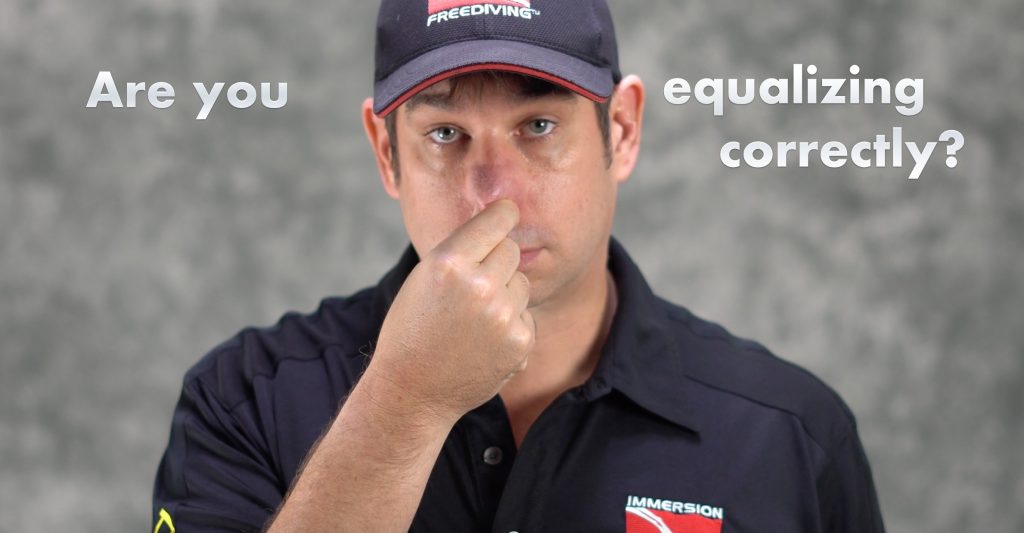
Tired of Ear Pain Limiting Your Freediving?
Here’s the dirty little secret in freediving classes: 20-40% of students get stuck 15-30ft due to equalizing.. This happens because they’re using the Valsalva method of equalization, which, although suitable for scuba diving, is terrible for freediving. Freedivers that use Valsalva be able to descend head first past about 30ft.
That’s why I developed an online course to teach the Frenzel technique. In my opinion, students should learn Frenzel BEFORE their freediving class begins. Most freediving classes simply don’t have the time or expertise to teach Frenzel. Many entry-level classes only offer one ocean session nowadays. So, if you show up for that ocean session still using the Valsalva method, you’ll likely be stuck at 15-30ft, leaving frustrated.
To maximize your learning experience, learn the Frenzel technique BEFORE your class starts. I can show you how.
The course boasts an impressive 89% success rate in teaching Frenzel. It has already taught over 1,000 students the method and comes with a 30-day money-back guarantee, so you have nothing to lose.
Learn more @ https://immersionfreediving.teachable.com/p/road-map-to-frenzel
How to Improve Your Freediving Ability with Ted Harty
If you want to dive deeper, stay underwater longer, and feel more comfortable at depth, then let me introduce you to my latest program: Freediving Training Secrets.
This is an online training program where I will share with you my 10 favorite dry land training exercises that you can do from home – no pool or ocean required – so that you can start diving deeper, staying longer, and feeling more comfortable.
Each week, I will tell you exactly which exercises we are doing, why we are doing them, and what I want you to think about during the exercises. As we progress week by week, you’ll build upon what you learned the previous week, ensuring there’s a logical training progression. You won’t be repeating the same exercises endlessly.
This is an excellent way to get the most out of your upcoming freediving course. By familiarizing yourself with the breath-holding aspect of freediving in advance, you’ll be able to concentrate on mastering the techniques during your class, without the distraction of your brain screaming, “Why aren’t you breathing!”
Learn more @ www.FreedivingTrainingSecrets.com





















